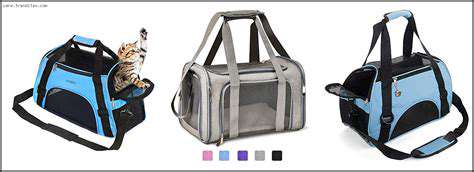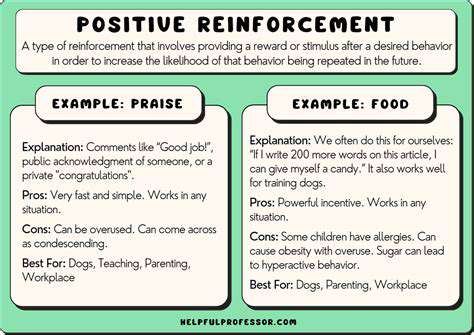Best Pet Carriers for Travel
Choosing the Right Carrier for Your Pet's Needs
Choosing a Carrier for Small Pets
Selecting the right carrier for a small pet, like a rabbit or a guinea pig, is crucial for their comfort and safety during travel. Consider the size and shape of your pet; a carrier that's too small can restrict movement and lead to stress, while one that's too large might feel empty and insecure. Look for carriers with secure latches and ventilation to ensure proper airflow, preventing overheating. A well-fitting carrier will also help minimize stress and anxiety during travel, allowing your pet to feel more secure and comfortable.
Fabric carriers are often preferred for small animals due to their breathability. However, ensure the fabric is durable and resistant to tearing or punctures. Hard-sided carriers provide extra protection and are often more secure, but might not offer the same level of ventilation. Ultimately, the best choice depends on your pet's individual needs and the environment you'll be traveling in. Consider the terrain and potential hazards when making your selection, and prioritize a carrier that allows your pet to stand, turn around, and lie down comfortably.
Selecting a Carrier for Larger Pets
Choosing a carrier for larger pets, such as dogs or cats, demands careful consideration of their size and breed. Ensure the carrier is spacious enough for your pet to stand comfortably, turn around, and lie down without feeling cramped. A carrier that's too small can lead to discomfort and anxiety, while a carrier that's too large might not provide the necessary security during transportation. Durability is key, as larger pets can be more prone to jostling the carrier during travel. Look for carriers made of sturdy materials that can withstand their energy levels.
For dogs, a hard-sided carrier is often a good choice for its durability and security. For cats, a soft-sided carrier might be preferable due to its flexibility and potential for easier access. Always prioritize proper ventilation, ensuring adequate airflow to prevent overheating, which is particularly important for dogs. Consider the potential for your pet to escape or injure themselves; a well-fitting carrier with secure latches and clasps is paramount.
Important Features to Consider
When evaluating pet carriers, several crucial features should be prioritized. Ventilation is paramount; ensure the carrier allows for sufficient airflow to prevent overheating, a common issue during travel. Secure closures and latches are essential to prevent escapes or injuries, especially important for larger or more active pets. Durability and sturdiness are key; the carrier should withstand the rigors of travel without compromising the safety of your pet. Consider the ease of cleaning, as spills and accidents can occur, and a carrier that's easy to clean will save you time and effort.
Portability is another factor to consider. A carrier that's easy to transport and handle will make travel smoother and less stressful for both you and your pet. Think about the type of travel you anticipate; will you be using public transportation, flying, or driving? The size and weight of the carrier should be considered in relation to the mode of transport you'll be using. Consider whether the carrier is easy to maneuver and fits your vehicle's dimensions if you're driving.
Safety and Security in Pet Carriers
Pet carrier safety is paramount. Ensure the carrier has secure latches and closures to prevent escapes, which are especially crucial for larger or more active pets. Consider the potential for injuries during travel; a well-constructed carrier with reinforced walls can minimize the risk of harm. Proper ventilation is vital to prevent overheating, a common hazard during travel. Look for carriers with multiple ventilation points to ensure sufficient airflow, especially for pets that are prone to overheating.
When traveling in vehicles, ensure the carrier is properly secured to prevent it from shifting or falling. When using public transportation, consider the regulations and guidelines for transporting animals. Following these guidelines will help ensure a safe and comfortable journey for your pet. Consider the terrain and potential hazards during travel. If traveling by car, consider securing the carrier in the vehicle's interior to ensure safety and prevent your pet from injuring themselves or others.
Top-Rated Pet Carriers Based on Customer Reviews

Choosing the Right Pet Carrier
Selecting the right pet carrier is crucial for the safety and comfort of your furry friend during travel. A well-designed carrier should provide ample space for your pet to stand, turn around, and lie down comfortably, minimizing stress and anxiety. Consider the size and breed of your pet when making your selection, ensuring there's enough room for growth, especially for puppies and kittens. Proper ventilation is essential for preventing overheating, a common concern during car rides or trips in warmer climates.
Different carriers cater to various needs and preferences. Some prioritize portability and lightweight design for easy handling, while others emphasize durability and safety features like reinforced walls or secure latching systems. Understanding your transportation needs and your pet's personality will aid in choosing the right carrier for your specific situation.
Durability and Safety Features
A robust and durable pet carrier is paramount for protecting your pet during travel. Look for materials that can withstand potential bumps and jostles, ensuring your pet's safety and security. The carrier's construction should prioritize your pet's well-being, preventing any potential injury or discomfort during transit. Consider carriers with reinforced walls and secure latches to prevent accidental opening and ensure your pet remains safely contained.
Safety features like padded interiors and ventilation systems are crucial for the comfort of your pet during long journeys. Ventilation is vital, preventing overheating and maintaining a comfortable temperature for your pet. A carrier that effectively manages airflow is essential for keeping your pet relaxed and healthy.
Ease of Use and Portability
The ease of use and portability of a pet carrier are important factors to consider. A lightweight and foldable design can make transport easier, while the carrier's size and shape should accommodate your transportation needs. Having a carrier that is easy to maneuver and handle is crucial, particularly when traveling with other luggage or in crowded environments. A carrier with a comfortable grip or handle can make carrying your pet more manageable.
Consider the size and shape of the carrier in relation to your vehicle or public transportation. A carrier that easily fits into a car's storage area or a train's compartment will make travel more convenient. A carrier that is easy to clean and maintain is also a practical choice for long-term use.
Tips for Choosing the Right Pet Carrier Size and Style
Choosing the Right Size for Your Pet
A crucial factor in selecting a pet carrier is its size. A carrier that's too small can cause stress and discomfort for your pet, hindering their travel experience. Conversely, a carrier that's too large can make the pet feel exposed and anxious, while also increasing the burden of carrying it. Thorough measurement of your pet, including their length, width, and height, is essential before purchasing. Consider the pet's expected growth rate, especially for puppies or kittens. An adjustable carrier could be a great option if you anticipate future growth.
Ensure the carrier allows your pet to stand comfortably, turn around completely, and lie down without feeling cramped. You'll want to avoid any restrictions on movement that could cause discomfort or anxiety during travel. A carrier that accommodates their natural posture is more likely to contribute to a positive travel experience.
Considering Your Pet's Needs and Temperament
Different breeds and types of pets have varying needs concerning carrier size and style. A smaller dog breed might thrive in a smaller carrier, whereas a larger dog may require a more spacious option. A nervous or anxious pet might benefit from a carrier with more enclosed features to provide a sense of security. Understanding your pet's personality and temperament is key to selecting the best carrier.
Consider your pet's usual behavior and any specific needs. Does your pet tend to get anxious during travel? A carrier with features like soft padding or calming scents might provide additional comfort. If your pet enjoys exploring, a carrier with ample ventilation might be better suited to keep them comfortable and at ease.
Exploring Different Carrier Styles
Pet carriers come in various styles, each with its own set of advantages and disadvantages. Hard-sided carriers offer durability and protection, while soft-sided carriers often provide more flexibility and portability. Think about the environment where you'll be using the carrier and select a style that best suits your needs. For example, a hard-sided carrier might be better for rougher terrain while a soft-sided carrier might be more convenient for carrying in crowded areas.
Consider factors like the ease of cleaning and maintenance. Some carriers feature removable liners or washable materials, which can make cleaning a breeze. Assess the durability of the carrier materials to ensure they can withstand the rigors of frequent travel and daily use. Also consider the aesthetics of the carrier to ensure it blends with your lifestyle.
Understanding Carrier Features
Features like ventilation and safety locks are vital in ensuring your pet's comfort and safety during travel. Adequate ventilation is crucial to prevent overheating, especially during warm weather. Look for carriers with multiple ventilation points or mesh panels for optimal airflow. Secure latches, buckles, and straps are essential to prevent accidental opening and ensure your pet's safety during transit.
Consider the presence of secure handles for easy carrying. If your pet is small or easily stressed, additional features such as a cushioned bottom or soft interior lining may enhance comfort. Ease of access to the carrier is important, too, as it can make loading and unloading your pet smooth and stress-free.
Evaluating Portability and Ease of Use
The portability of a pet carrier is a significant consideration. A lightweight and compact carrier is ideal for frequent travel. Look for carriers with handles or straps that provide comfort during extended carrying periods. Ensure the carrier design allows for smooth and simple loading and unloading of your pet.
Consider how easily you can maneuver the carrier in various environments. Will it fit into your car's backseat or under your seat? Will it be convenient to use on public transportation? Think about your lifestyle and choose a carrier that complements your travel needs.
Budgeting for Your Carrier Needs
Pet carriers vary significantly in price, so establishing a budget beforehand is helpful. Consider the features and durability you desire when setting your budget. A higher-priced carrier might offer superior quality, safety, and comfort, while a more economical option might suffice for occasional use. Don't sacrifice quality for a lower price, especially if safety is a concern.
Compare different carriers to ensure you're getting the best value for your money. Read reviews from other pet owners to get insights into the durability and functionality of various carriers. Consider the long-term value of the carrier and how it will contribute to your pet's well-being.
Assessing Carrier Safety Standards
Pet carrier safety is paramount. Ensure the carrier complies with relevant safety standards to guarantee your pet's well-being during travel. Look for carriers certified by reputable organizations, and read reviews to assess the overall safety rating. Consider the materials used and their ability to protect your pet from potential injuries or hazards.
Make sure the carrier is adequately reinforced to withstand the stresses of travel. Examine the stitching, buckles, and fasteners to identify any potential weaknesses. A secure carrier is essential to protect your pet from injury and ensure a smooth and safe journey.
Read more about Best Pet Carriers for Travel
Hot Recommendations
- Review: [Specific Brand] Small Animal Cage
- Why Rescuing Pets Saves Lives
- Best Pet First Aid Kits [What to Include]
- How to Help Stray Animals in Your Community
- Guide to Adopting a Pet When You Have Kids
- Top Reptile Heat Lamps
- Heartwarming Rescue Stories That Will Inspire You
- Review: [Specific Brand] Bird Cage
- Best Aquarium Filters [2025 Review]
- Review: [Specific Brand] Smart Litter Box


![Best Pet Carriers for Airline Travel [Review]](/static/images/33/2025-05/TopCarrierChoices3AAComparativeLook.jpg)




![Life with My [Specific Pet Type/Breed] [Pet Diary]](/static/images/33/2025-07/TheUnbreakableBond3AMyPersianCompanion.jpg)



